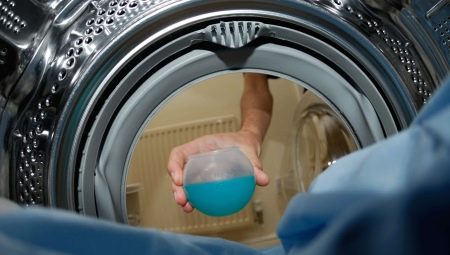Today, membrane clothes are chosen and loved not only by professional athletes: skiers, snowboarders, but also tourists and ordinary people who like to feel comfortable and comfortable in various weather conditions. Such products are unique due to their high-tech properties.

A little about the properties of the membrane
The membrane is a thin film with very small pore openings, which are produced using a specific technology. The shape of the pores has such a structure that provides the material with one-sided permeability. Membrane tissue is mainly synthetic material, on the inside of which a membrane film is applied in a special way. It allows you to remove moisture that forms under clothing in the environment, and moisture outside does not allow to get inside.
Thus, the fabric “breathes” and guarantees comfort to people who are physically active in the fresh air.
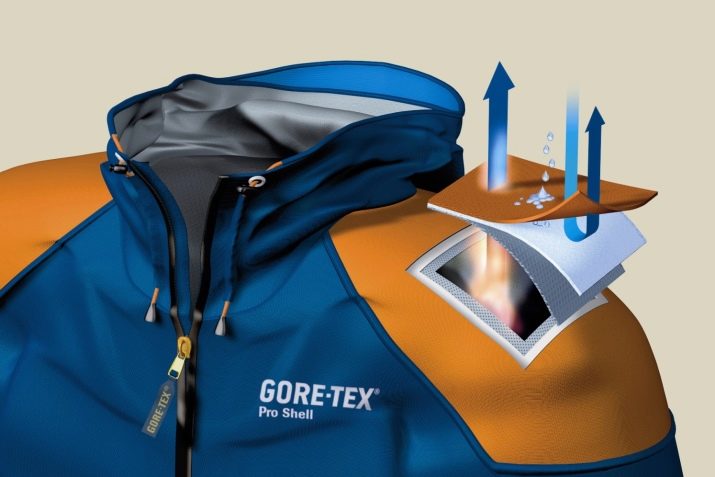
Typically, the surface of the membrane tissue is treated with a special, water-repellent impregnation, so that moisture falling on clothes rolls in drops. This allows you to significantly reduce the load on the membrane and additionally protect things from getting wet. The membrane also protects against wind. Higher characteristics of such fabric make it much stronger and also much lighter.
By design features, such a fabric is of three types:
- Two-layer. Here the membrane is “welded” to the outer layer of fabric from the wrong side.In such clothes, there is always a lining, which is used to protect the membrane from clogging and various damage;
- Two-layer and a half. In the structure of this fabric, the membrane is protected by a foamed protective layer, which covers the inside of a two-layer fabric. Membrane clothing made of such a material is much lighter than a three-layer one and requires a lining;
- Three-layer, where the wrong side is a fabric with a fairly fine mesh. All the components of this fabric: the membrane, the upper part and the knitted mesh are glued into a single structure by lamination, where it is the mesh that performs the protective function of the membrane from damage and contamination.
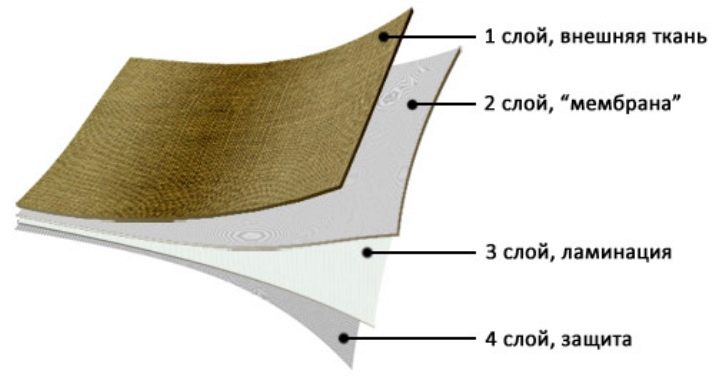
Membranes in their structure are pore, pore-free and combined:
- Pore It has a large number of microscopic pores on the outer layer, and because of their incredibly small size, the material does not allow moisture to pass from the outside, but allows fumes that collect under clothes to go outside. The main disadvantage of such a fabric is that during the wear of the product, the pores of the membrane become clogged and the air ceases to circulate efficiently, and if the product is improperly cleaned or washed, the product will leak;
- Surface nonporous the membrane has no pores in its structure, therefore, due to the lack of access paths, water cannot leak into the clothes. The warm air that forms inside builds up on the inner layer of the membrane and evaporates very slowly, so the material may seem moist after some time;
- Combined characterized in that a protective coating is applied to the surface of the pore base. It combines the functions of both a pore and non-pore membrane, therefore it is considered the best composition of membrane tissue, the most effective to use. Its pores are not clogged, and the steam accumulated in the clothes is freely brought out. However, a fabric with such a composition and products made from it are of a rather high cost.
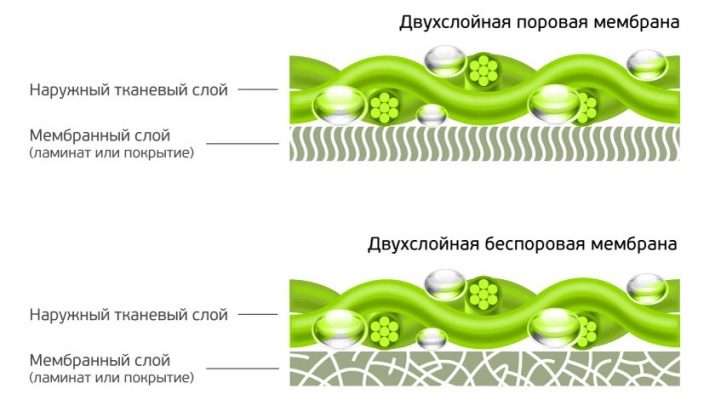
The properties of this fabric allow you to produce various high-quality and comfortable sportswear for competitions, hiking and skiing, hunting and fishing. It can be snowboard jackets, ski suits, warm overalls. Very popular, especially in the winter, children's clothes from similar fabrics, it is lightweight, allows you to move freely and does not get wet. Using membranes, snowboard elements for riding clothes are also produced: gloves, hats, sweatshirts. Today, in the Russian market, there are many different membrane tissues, but one of the most famous, popular and high-quality is gore-tex.
It is impossible to buy such a membrane in the form of fabric, and only certified manufacturers are allowed to produce things with its use.



How to wash?
Membrane fabric is a high-tech material that requires proper and delicate care, so as not to damage its protective properties. Washing, especially hand washing, is a very good way to clean a jacket, overalls or other items of equipment from such a fabric from contamination. Subject to all recommendations and care rules, such clothes will not lose their properties, even due to repeated machine washings.
To wash membrane products regular powder cannot be used, because it contains aggressive substances, chlorine, bleaches, is poorly soluble in water, which can damage and spoil the membrane.
Ideally, it is better to use special detergents for washing membrane fabrics, they are sold in any hardware stores.
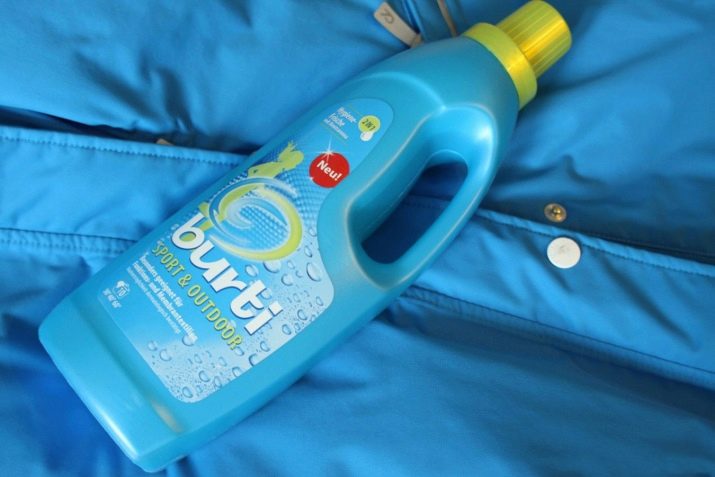
They can be just cleaning, but you can buy a special gel, which also includes impregnation. So after washing with such a tool, there is no need to additionally soak your clothes with a water-repellent spray.
One of the best special detergents is considered Nikwax Tech Wash. It removes dirt well, preserving all the functional features of the membrane. Also perfectly wash various contaminants Denkmit Fresh Sensation-gel, DOMAL Sport Fein Fashion-balm. But if such a tool was not at hand, you can use simple gel-like liquids.
You can also use laundry or liquid soap as a cleaning element. They do not have an aggressive environment and are ideal for any membrane fabric product.
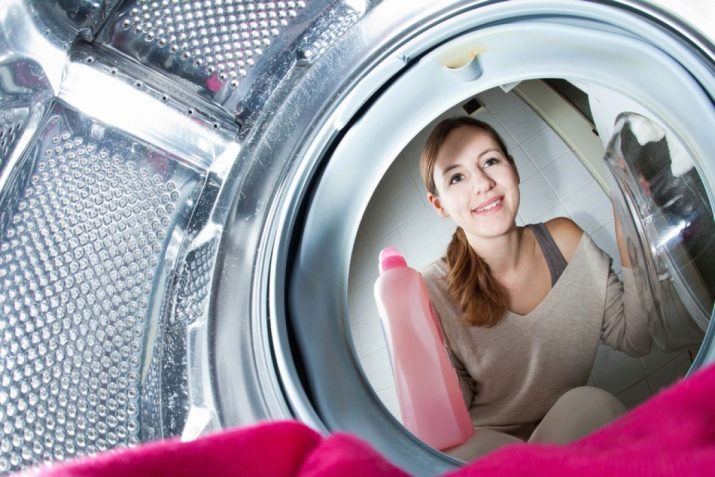
Important, so that means for cleaning such clothes contained more natural ingredientsc, were soft in chemical properties, which will help membrane products maintain their quality functions longer.
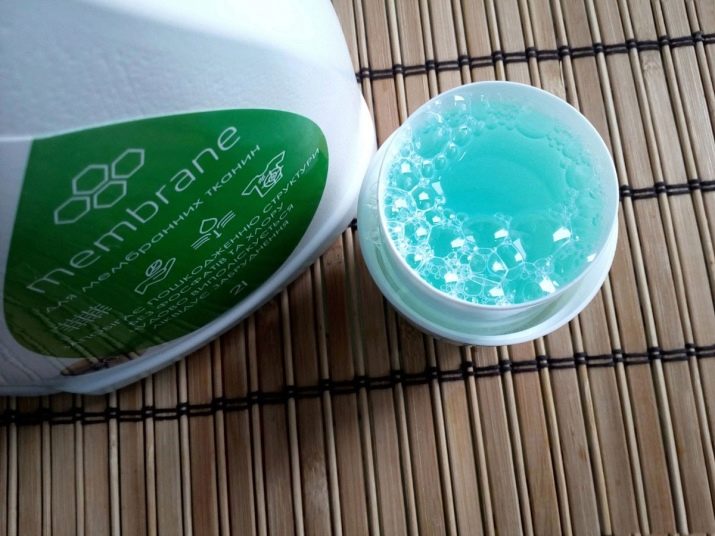
Washing features
Machine washing of various membrane products has a number of features. To wash the clothes from the membrane fabric in the machine correctly, You must complete the following steps:
- Before loading such clothes into the washing machine, it is necessary to fasten all the locks, zippers and pockets;
- Carefully study and follow the clothing care recommendations indicated by the manufacturer on the label;
- Choose the most gentle washing mode available in your washing machine, for example, delicate or manual;
- If there are several things, it is advisable not to immediately put everything in the machine, but to wash each separately;
- It is better to wash membrane clothes at a temperature of no higher than 30 degrees. The lower the temperature of the water, the better; in no case should the water be hot;
- It is important to turn off the spin mode completely, since any mechanical action on the membrane will lead to the destruction of pores, so even manual spin is contraindicated;
- After washing, the product must be rinsed well to get rid of the remnants of the detergent. Then you need to carefully remove the clothes, hang them on a hanger and allow excess water to drain;
- It is forbidden to dry such a fabric on radiators, near an open flame, or in a washing machine. To dry a thing well, it must be carefully straightened, laid horizontally on a dry, clean cloth or towel and periodically turned over. It is advisable that the room is well ventilated.


Useful Tips
In the process of washing any clothes made of membrane fabric, you can not use all kinds of solvents, stain removers, various aggressive mixtures so as not to destroy the membrane. It is also contraindicated to use conditioners, since they create a film on the fabric, which will greatly harm the material.
You cannot iron such a fabricThe action of heat can damage its structure. Just flatten the thing to avoid creases and wrinkles.
Please note that membrane jackets, overalls do not pre-soak. A long stay in water significantly impairs the properties of such a fabric, and such clothes can be well washed without prolonged soaking.
If you constantly wear products made of membrane fabric, you must wash them at least once a month so that particles of dust and dirt do not clog the pores of the membrane.

In order for such things to serve you for a long time, they must be treated with fluorine, which is produced in the form of a spray and applied to the washed and well-dried surface of the product. It is advisable to apply such a spray after each wash, this gives additional protection to the membrane properties of clothes, eliminates burnout and increases wear resistance.
For small soiling there is no need to use machine wash. In this case, it is better to clean the soiled areas of the top of the product manually. This can be done using a soap solution or a special tool. It is necessary to carefully handle the dirt with a brush or sponge, without applying much effort to damage the fabric.

It is not recommended to fold and twist products made of membrane fabric during storage, therefore, after stripping, your jacket, suit or jumpsuit should be hung flattened on its shoulders, previously packed in a clothing cover or bag. If dust gets on the clothing, it will clog the pores of the membrane and reduce the consumer qualities of the product.
Proper care and washing of products from membrane fabric will allow you to serve you for many years without losing their basic functions, and will make it possible to spend a long time outdoors, in comfortable conditions, even at a fairly low air temperature.
For more information on how to wash membrane clothes in the washing machine, see the next video.
